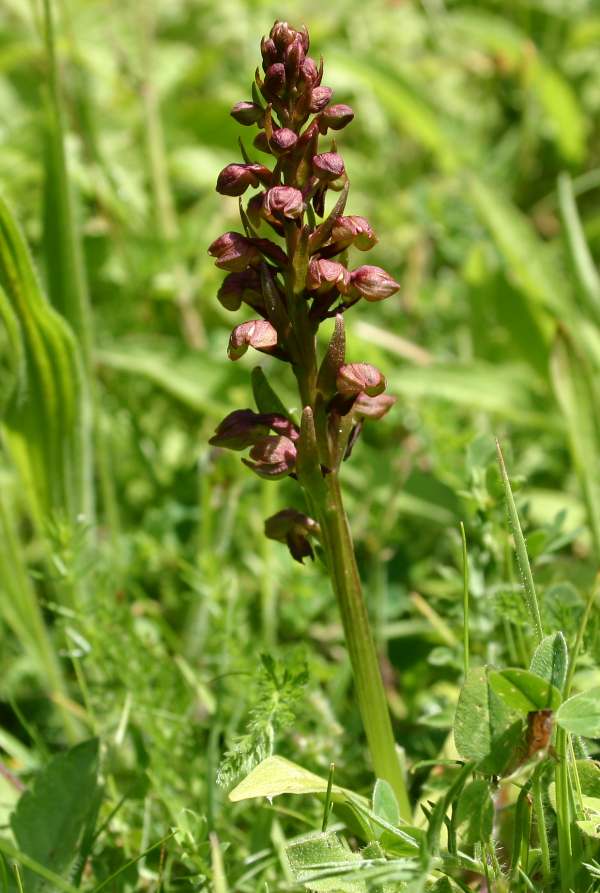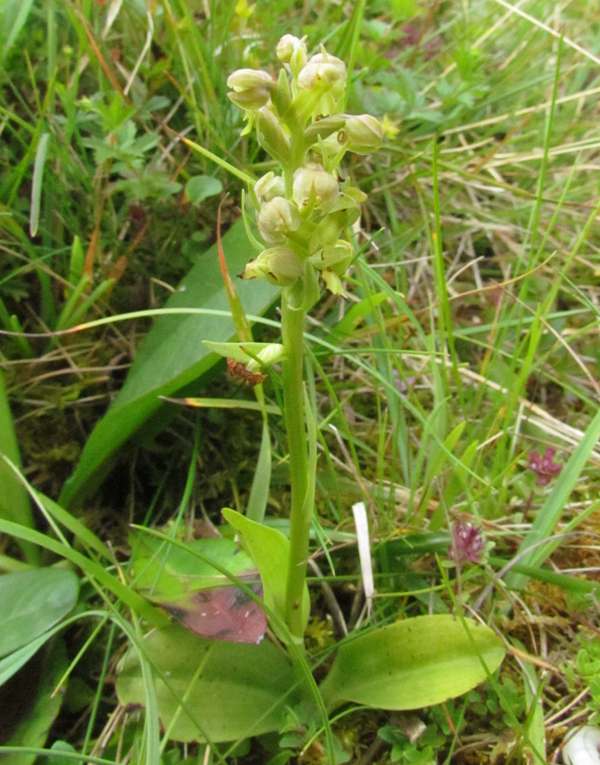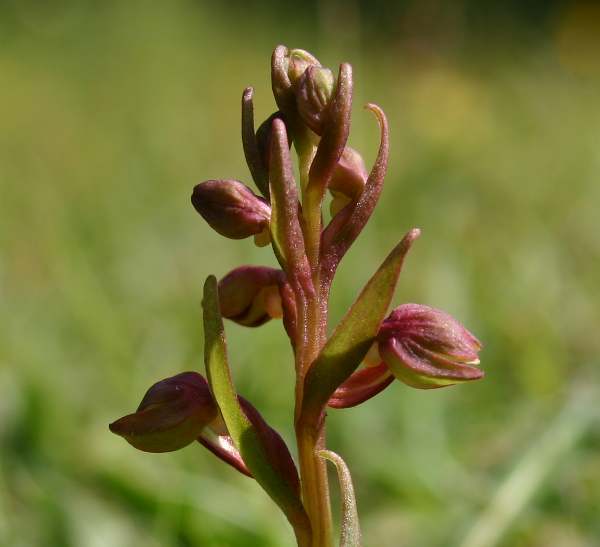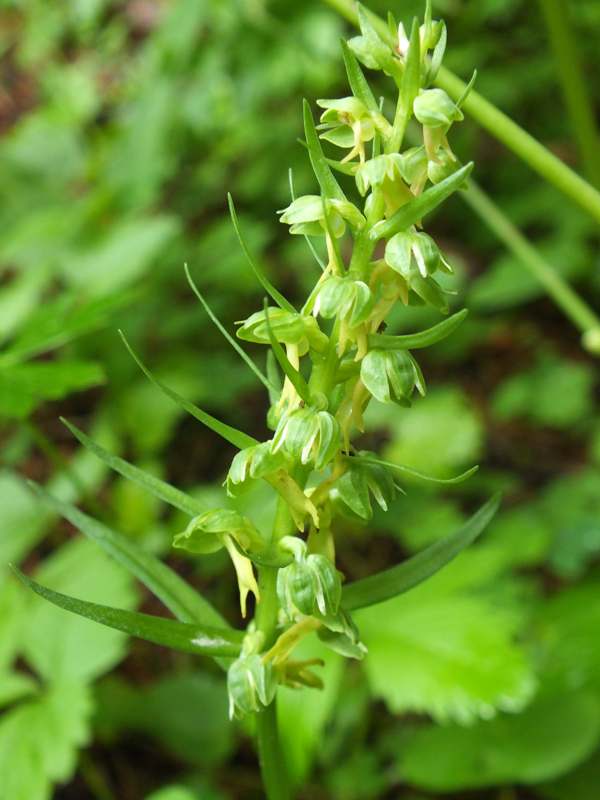Trees Birds Mammals Fish Amphibians Reptiles
Wild Algarve
Bookshop
Dactylorhiza viridis - Frog Orchid
Phylum: Magnoliophyta - Class: Liliopsida - Order: Orchidales - Family: Orchidaceae

Formerly placed in its own genus, Coeloglossum, the Frog Orchid was reclassified following the discovery that its genetic makeup is very similar to that of the Spotted-orchids and Marsh-orchids, with which it sometimes hybridises.

Above: x Dactylorhiza mixtum, the hybrid between Frog Orchid and Common Spotted-orchid, Pepperbox Hill, near Salisbury, in 1964.
Description
Hard to spot on even closely cut or grazed turf due to its small size (normally 5 to 15 cm tall) the Frog Orchid's flowers are supposed to resemble frogs. It depends on how vivid an imagination you have!
This inconspicuous orchid has 3-5 dark green leaves. The leaves at the base of the plant are blunt but those occuring higher up the stem are narrow and pointed. The inflorescences of Frog Orchids vary considerably in size and carry between 5 and 25 individual flowers, which are green in parts and often a dark brownish-red in others.

Distribution
Dactylorhiza viridis is widespread throughout the UK and Ireland but its numbers are in steep decline due to habitat destruction and the ploughing up of so many of our ancient pastures. In Europe the Frog Orchid is suffering the same plight, but nevertheless it is still to be found from Scandinavia right down as far south as the mountain areas of Spain and Greece.
In North Wales one or two plants have returned to the Anglesey Fens National Nature Reserves in recent years, and in 2014 they were also rediscovered at Minera Quarry near Wrexham, where they had not been seen for a very long time.

Habitat
Ancient chalk grassland and meadows are the favoured habitat of the Frog Orchid. Although they can be very difficult to spot, in the best sites there can be thousands of plants which often go unnoticed.
Flowering times
June and July are the best months to see the Frog Orchid.
The specimens shown on this page were photographed in south-west Ireland and at Noar Hill in Hampshire in June.

Dactylorhiza viridis var. longibracteatum
Varieties and Hybrids
Varieties
Var. longibracteatum is a taller and more robust plant and has much longer bracts. It is recorded from Northern England.
Inter-generic Hybrids
X Dactyloglossum mixtum is a hybrid with Dactylorhiza fuchsii. It is rare but is reported from scattered locations.
X Dactyloglossum conigerum is a hybrid with Heath Spotted-orchid Dactylorhiza maculata. It is rare.
X Dactyloglossum viridellum is a hybrid with Northern Marsh-orchid Dactylorhiza purpurella. It is recorded from the Outer Hebrides and Co. Durham.
X Gymnoglossum jacksonii is a hybrid with Chalk Fragrant-orchid Gymnadenia conopsea. It is widely reported in England.
Etymology
The genus name Dactylorhiza means 'finger-like roots', while the specific epithet viridis means 'green'.
Reference sources
The Plant List
Sue Parker (2023) Wild Orchids of Wales - how, when and where to find them; First Nature e-book (Amazon Kindle format)
Anne and Simon Harrap (2005) Orchids of Britain and Ireland; A&C Black
Pierre Delforge (2005) Orchids of Europe, North Africa and the Middle East; A&C Black
Den Nordiska Floran (1992) Bo Mossberg, Stefan Ericsson and Lennart Stenberg; Wahlstrom & Widstrand
Acknowledgements
This page includes pictures kindly contributed by Betty and Tony Rackham.
Sue Parker's latest ebook is a revised and enlarged edition of Wild Orchids in The Burren. Full details here...
Buy it for just £5.95 on Amazon...
Sue Parker's new ebook is a comprehensive and fully revised edition of her acclaimed field guide to the Wild Orchids of Wales. Full details here...
Buy it for just £5.95 on Amazon...
Sue Parker's 5-star acclaimed field guide to the Wild Orchids of the Algarve is now available as an ebook. Full details here...
Buy it for just £5.95 on Amazon...
Please Help Us: If you have found this information interesting and useful, please consider helping to keep First Nature online by making a small donation towards the web hosting and internet costs.
Any donations over and above the essential running costs will help support the conservation work of Plantlife, the Rivers Trust and charitable botanic gardens - as do author royalties and publisher proceeds from books by Pat and Sue.